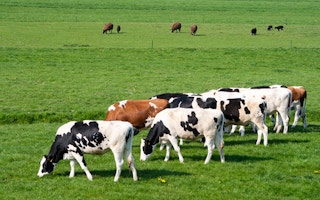Here’s a way to make cattle emit lower volumes of methane through their digestive tracts: give the beasts a higher-quality diet. That way, you get more stock on less grassland, get improved yields per hectare and at the same time reduce greenhouse gas emissions, according to new research in the Proceedings of the National Academy of Sciences.
“There is a lot of discussion about the reduction of meat in the diet as a way to reduce emissions,” says Petr Havlik of the International Institute for Applied Systems Analysis in Austria. “But our results show that targeting the production side of agriculture is a much more efficient way to reduce greenhouse gas emissions.”
This will provoke some argument, and in any case seems counter-intuitive. Campaigners have been arguing for decades that livestock farming is in many though not all regions an inefficient way to produce nourishment: grain, pulses, fruits and vegetables deliver greater outputs of calories and proteins at much lower overall costs in water, energy and emissions.
Farm animals are responsible for 12 per cent of greenhouse gas emissions and, as the poorer nations develop, demand for meat and dairy protein tends to rise, so emissions are expected to increase.
Production economics
Volume for volume, methane or natural gas is a far more potent greenhouse gas than carbon dioxide, and researchers in Europe and the US have begun to consider ways of reducing or at least limiting methane discharges from either or both ends of billions of the planet’s grazing animals.
“
Farm animals are responsible for 12 per cent of greenhouse gas emissions and, as the poorer nations develop, demand for meat and dairy protein tends to rise, so emissions are expected to increase
But Havlink and colleagues from Africa, the Caribbean, Australia, Europe and the US think the answer lies in the changing economics of production. Livestock provide a third of the protein in human diets: in the developing world oxen, donkeys and buffalos also deliver haulage, manure and regular income.
Around 30 per cent of the global land area is used to rear livestock. Between 1980 and 2000, 83 per cent of the expansion of agricultural land in the tropics was at the expense of the tropical forests. A lot of this space is devoted to cattle, sheep and goats. Increasing quantities of maize and soya are also being converted to animal feed. So the problem is not likely to go away.
As land prices rise, there is pressure to stock more animals and buy in high-density fodder, to increase yield and to deliver quicker returns. So the new research proposes that both the increase in the cost of land, and the still-rising yields per hectare from croplands, will lead to richer diets for animals: this in turn would pay off in greater returns for the farmers, higher yields for people and – because livestock diets would be lower in cellulose and richer in energy – lower emissions of methane from the flatulent animals.
Better option
The scientists argue that by 2030 the change to more efficient farming could cut emissions by 736 million tonnes of carbon dioxide equivalent per year. That, they suggest, could happen anyway, because it pays farmers to do such things. If political and economic measures were taken to accelerate such changes – and at the same time reduce the conversion of forest to farmland – then the world could save 3,223 million tonnes of CO2 equivalent a year.
The real target in all this is not the livestock, but the change in land use. Stringent climate change policies, were they ever to be enforced or even introduced by the governments of the world, could constrain the food available to a swelling population. The researchers argue that it would be five to 10 times more efficient and effective to reduce the changes in land use – to stop burning and clearing forests to make new grazing land.
All this involves complex economic reasoning, and the use of economic metrics such as “total abatement calorie cost” and “marginal abatement costs”, but a global package of measures that included investment, trade and education could reduce total emissions from the farms and cattle sheds by 25 per cent.
“From the livestock sector perspective, limiting land use change seems the cheapest option both in terms of the economic cost and in terms of impact on food availability,” says Havlik.

















